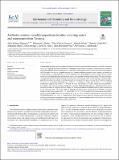| dc.description.abstract | Antimicrobial resistance against certain medications in the pathogenic microbial community is globally increasing due to the continual discharge and disposal of pharmaceuticals in the environment. The phenomenon resulted in significant antibiotic resistance among several exposed Enterobacteriaceae species, with wastewater treatment plants (WWTPs) and rivers serving as significant reservoirs. Despite antibiotic resistance being a tragedy, particularly in treating diseases by using antibiotics, local and regional studies indicating the severity, resistant species and the molecular level insight into these pathogens are scarce, thus requiring immediate intervention. This study, therefore, investigated wastewater from wastewater treatment ponds and receiving waters for the presence of resistant pathogens through phenotypical and molecular approach screening of their genes. Among the 57 analyzed samples, 18 (67%, n = 27) isolates of Klebsiella spp.., 4 (80%, n = 5) isolates of Proteus spp., 1 (100%, n = 1) of isolated Pseudomonas aeruginosa and 6 (18%, n = 34) of E. coli found were resistant to at least 1 among the tested antibiotics. E. coli had an 83% higher proportion of multi-drug resistance (MDR) than Klebsiella spp.., which had 68.5%, and no MDR was shown by P. aeruginosa isolates. Among the 20 bacterial isolates of antibiotic-resistant genes, showed that E. coli harboured 39%, followed by 22% of Klebsiella spp. Eleven (11) isolates of these 20 (55%) contained sulphonamides resistant genes: Sul 1 (n = 4) and Sul 2 (n = 7). Ten (10) isolates (50%) contained the tetracycline-resistant genes in which 4 isolates showed the Tet A, Tet B – 1 and 5 isolates contained Tet D. β-lactamases (bla CTX-M and bla SHV) were found in 7 isolates (35%). The existence of these antibiotic-resistant species in the urban receiving and wastewater presents a threat of transmission of diseases to humans and animals that are not cured by the existing medications, jeopardizing public health safety. | en_US |

